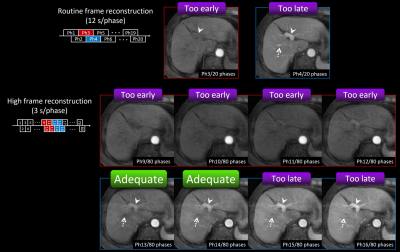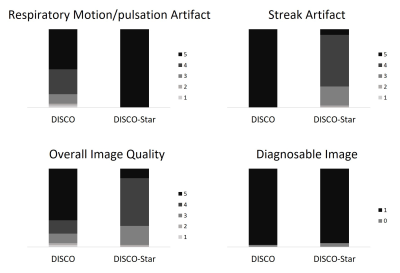Shintaro Ichikawa1, Utaroh Motosugi2, Tetsuya Wakayama3, Satoshi Funayama1, Daiki Tamada1, Sagar Mandava4, Ty A Cashen5, and Hiroshi Onishi1
1Department of Radiology, University of Yamanashi, Chuo, Japan, 2Kofu Kyoritsu Hospital, Kofu, Japan, 3GE Healthcare, Hino, Japan, 4GE Healthcare, Atlanta, GA, United States, 5GE Healthcare, Madison, WI, United States
1Department of Radiology, University of Yamanashi, Chuo, Japan, 2Kofu Kyoritsu Hospital, Kofu, Japan, 3GE Healthcare, Hino, Japan, 4GE Healthcare, Atlanta, GA, United States, 5GE Healthcare, Madison, WI, United States
Adequate scan
timing of AP in DISCO-star with routine time frame (12 s/phase) ranged from phase
3 to 5. Although nine patients missed adequate timing, high frame rate reconstruction (3 s/phase)
salvaged adequate images.

Fig. 4. Example of the utility of high frame rate reconstruction.
Adequate scan timing of arterial phase (AP)
was not observed on routine frame
reconstruction (12 s/phase). Portal vein (arrowhead) was not enough
enhanced in the 3rd phase and hepatic vein (dotted arrow) was already enhanced
in the 4th phase. Optimal AP was obtained with high frame rate reconstruction (3 s/phase). Portal vein
(arrowhead) was enhanced but the hepatic vein (dotted arrow) was not yet
enhanced in the 13th and 14th phase.

Fig. 5. Stacked bar graph representing
results of the visual assessment.
No respiratory motion/pulsation artifact was
observed in DISCO-Star dataset (P
< 0.0001). DISCO-Star showed lower score of streak artifact and overall
image quality (P < 0.0001).
However, there was non-inferiority in the proportion of diagnosable image in DISCO-Star
dataset in comparison with DISCO dataset.